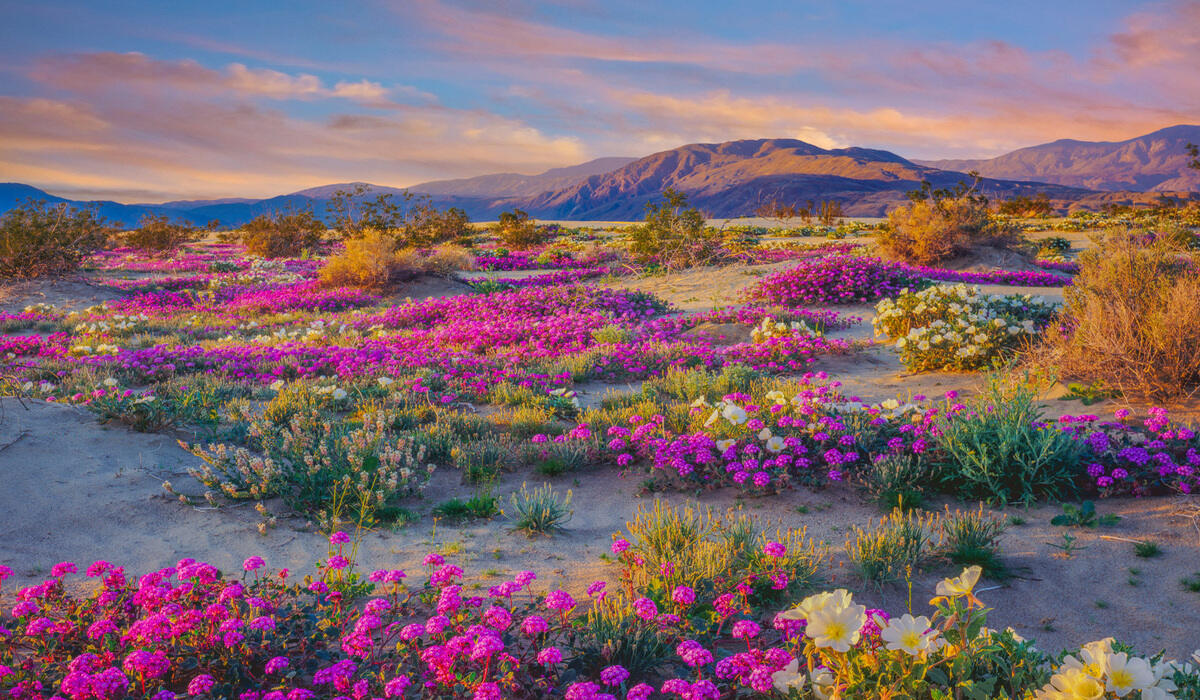
Desert wildflowers are a captivating and resilient aspect of nature, thriving in seemingly inhospitable environments. Their vibrant blooms bring life and color to arid landscapes, offering a breathtaking spectacle for those fortunate enough to witness them. In this article, we'll delve into the fascinating world of desert wildflowers, uncovering their remarkable adaptations, ecological significance, and the diverse species that call these harsh environments home. From the iconic Saguaro cactus blooms of the Sonoran Desert to the delicate beauty of the Mojave aster, each wildflower holds a unique story waiting to be discovered. Join us as we explore 18 intriguing facts about these tenacious blooms, shedding light on their extraordinary survival strategies and the vital role they play in the delicate balance of desert ecosystems. Let's embark on a journey through the arid terrain, where bursts of color emerge against the odds, showcasing the awe-inspiring resilience and beauty of desert wildflowers.
Key Takeaways:
- Desert wildflowers bring vibrant colors to harsh deserts, showcasing nature’s resilience and beauty. They play a crucial role in supporting diverse ecosystems and have deep cultural and medicinal significance.
- The annual wildflower blooms in the desert create a seasonal spectacle, drawing visitors from far and wide. Efforts to preserve and protect these delicate blooms are crucial for future generations to enjoy.
Desert Wildflowers: Nature's Colorful Masterpieces
Desert wildflowers are nature's vibrant masterpieces, adorning arid landscapes with their breathtaking hues. Here are 18 fascinating facts about these resilient blooms that thrive in the harsh desert environment.
Burst of Color in Arid Landscapes
Desert wildflowers, such as the vibrant Desert Marigold and the delicate Fairy Duster, bring a burst of color to the otherwise harsh and arid landscapes. These resilient blooms have adapted to thrive in the challenging conditions of the desert, showcasing nature's remarkable ability to flourish in adversity.
A Symphony of Species
The desert is home to a diverse array of wildflower species, each with its own unique characteristics and adaptations. From the iconic Saguaro cactus blooms to the fiery red hues of the Indian Paintbrush, the desert landscape is transformed into a symphony of colors during the wildflower season.
Survival Strategies
Desert wildflowers have evolved ingenious survival strategies to endure the extreme conditions of their habitat. Some species, like the Desert Lily, lie dormant for years, waiting for the perfect conditions to bloom, while others, such as the Desert Sunflower, have developed specialized mechanisms to minimize water loss and thrive in the arid environment.
Nature's Timekeepers
The blooming of desert wildflowers is a testament to nature's impeccable timing. These blooms often coincide with the arrival of spring, signaling the end of the harsh winter and the beginning of a season of renewal and growth. The sight of vast desert landscapes carpeted with wildflowers is a breathtaking reminder of nature's resilience and beauty.
A Pollinator's Paradise
Desert wildflowers play a crucial role in supporting diverse ecosystems by providing nectar and pollen for a myriad of pollinators. Bees, butterflies, hummingbirds, and other insects and birds flock to these blooms, ensuring the vital process of pollination and contributing to the rich tapestry of desert life.
Cultural Significance
For indigenous communities and desert-dwelling cultures, wildflowers hold deep cultural and spiritual significance. These blooms are often woven into traditional ceremonies, art, and folklore, symbolizing resilience, renewal, and the interconnectedness of all living beings with the natural world.
A Photographer's Delight
The breathtaking beauty of desert wildflowers has captivated photographers and nature enthusiasts for generations. The juxtaposition of vivid blooms against the stark desert backdrop creates a visual spectacle that has inspired countless works of art, photography, and creative expression.
Nature's Pharmacy
Several desert wildflowers possess medicinal properties and have been used for centuries by indigenous communities for their healing properties. From the soothing qualities of the Desert Lavender to the traditional uses of the Desert Globemallow in herbal remedies, these blooms offer a treasure trove of natural remedies.
Adaptations to Arid Conditions
The remarkable adaptations of desert wildflowers to thrive in arid conditions are a testament to nature's ingenuity. From deep-reaching root systems that tap into hidden water sources to waxy coatings that minimize water loss, these blooms have evolved to conquer the challenges of the desert environment.
Ecological Resilience
The presence of wildflowers in the desert ecosystem is a testament to the resilience and adaptability of nature. These blooms not only beautify the landscape but also contribute to soil stabilization, erosion control, and the overall health of desert ecosystems, showcasing their vital ecological role.
A Seasonal Spectacle
The blooming of desert wildflowers heralds the arrival of a seasonal spectacle that draws visitors from far and wide. The annual wildflower season transforms the desert into a kaleidoscope of colors, attracting nature enthusiasts, hikers, and admirers eager to witness this awe-inspiring natural phenomenon.
Conservation Challenges
Despite their resilience, desert wildflowers face conservation challenges due to habitat loss, climate change, and human impact. Efforts to preserve and protect these delicate blooms and their fragile ecosystems are crucial to ensuring the continued splendor of desert wildflowers for future generations.
Nature's Masterpieces
Desert wildflowers stand as nature's living masterpieces, showcasing the beauty and resilience of life in some of the harshest environments on the planet. Their vibrant blooms serve as a reminder of the remarkable adaptability and enduring spirit of the natural world.
A Source of Inspiration
The captivating allure of desert wildflowers has inspired poets, artists, and storytellers throughout history. Their ephemeral beauty and tenacious spirit have been immortalized in literature, art, and folklore, serving as a timeless muse for creative expression and human imagination.
Sustainable Tourism
The annual wildflower blooms in the desert have given rise to sustainable nature-based tourism, providing economic opportunities for local communities while raising awareness about the importance of preserving these delicate ecosystems for future generations to enjoy.
Nature's Resilient Artists
Desert wildflowers, with their vibrant blooms and tenacious spirit, stand as nature's resilient artists, painting the arid landscapes with a palette of colors and inspiring awe and wonder in all who behold their fleeting yet magnificent display.
Guardians of Biodiversity
The preservation of desert wildflowers is essential for safeguarding biodiversity and maintaining the delicate balance of desert ecosystems. By protecting these blooms and their habitats, we uphold the rich tapestry of life that depends on the resilience and beauty of desert wildflowers.
The 18 Desert Wildflowers Facts presented here offer a glimpse into the captivating world of these resilient blooms, showcasing their ecological significance, cultural importance, and enduring beauty. As nature's vibrant masterpieces, desert wildflowers continue to inspire and enchant, reminding us of the remarkable resilience and beauty that thrives in even the harshest of environments.
Conclusion
In conclusion, desert wildflowers are not only stunning in their beauty but also play a crucial role in the fragile ecosystems of arid regions. Their ability to thrive in harsh conditions and their unique adaptations make them a fascinating subject of study and admiration. By understanding the diverse species of desert wildflowers and their significance, we can better appreciate the resilience and beauty of nature. Whether it's the iconic Saguaro cactus blooms or the delicate Desert Marigold, these wildflowers remind us of the remarkable diversity and tenacity of life in the desert.
FAQs
What are some common desert wildflowers?
Common desert wildflowers include the Saguaro cactus bloom, Desert Marigold, Brittlebush, Desert Globemallow, and Desert Sunflower. These resilient plants have adapted to thrive in arid environments, showcasing vibrant colors and unique characteristics.
How do desert wildflowers survive in harsh conditions?
Desert wildflowers have evolved various survival mechanisms to thrive in arid environments. Some have deep root systems to access water, while others have thick waxy coatings to reduce water loss. Additionally, many desert wildflowers have adapted their blooming patterns to coincide with brief periods of rainfall, ensuring their reproductive success in challenging conditions.
Was this page helpful?
Our commitment to delivering trustworthy and engaging content is at the heart of what we do. Each fact on our site is contributed by real users like you, bringing a wealth of diverse insights and information. To ensure the highest standards of accuracy and reliability, our dedicated editors meticulously review each submission. This process guarantees that the facts we share are not only fascinating but also credible. Trust in our commitment to quality and authenticity as you explore and learn with us.


